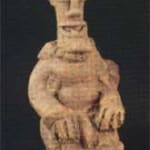Komaland Sculpture of a Seated Man, 13th Century CE - 18th Century CE
Terracotta
3.5 x 7
PF.1457 (LSO)
This outstanding sculpture of a seated man is a rare anthropomorphic figure from one of Africa’s least understood groups; the Koma people of Northern Ghana. It is remarkably detailed and...
This outstanding sculpture of a seated man is a rare anthropomorphic figure from one of Africa’s least understood groups; the Koma people of Northern Ghana. It is remarkably detailed and superbly preserved. It represents an older male, seated on the ground (?), his hands resting on his lap. Irregularity of textures suggests the representation of textiles, but the phallus is erect and very evident. Detail is incised and hatched, from the fingers to the texture of the cloth. The neck is surrounded by an incised collar-like arrangement, from which protrudes a naturalistic, high, bald and domed head with heavily rimmed eyes, a wide nose and an open mouth. The chin is square, perhaps representing a beard.
The Komaland people are almost completely obscure, and since the original discovery of their artefacts in 1985 very little further research has been carried out. Basic dating indicates a range of perhaps 500 years between the 13th and 18th centuries. They are known to have been very able ceramicists, and made pots, figures, heads, talismans (anthropomorphic and zoomorphic) and a variety of other items; they were also, unusually, competent metalworkers, and produced a plethora of weaponry and ornate helmets. Their society was presumably sedentary, agricultural and hierarchical, as indicated by the range of crafts available, the tumuli in which they were found, and the size of the sites.
In terms of ceramics, there is an unusually high percentage of deformed and heavily stylised figures; the significance of this remains uncertain. In the current case, an older man may be a high-status figure in a gerontocratic system (as is common in the pre-industrial world), a figure from Koma mythology, reproduced in his honour, or even a fanciful construction or experiment by a imaginative and accomplished ceramicist.
Whatever the reason for its manufacture, however, this is a rare and fascinating piece of ancient African art.
The Komaland people are almost completely obscure, and since the original discovery of their artefacts in 1985 very little further research has been carried out. Basic dating indicates a range of perhaps 500 years between the 13th and 18th centuries. They are known to have been very able ceramicists, and made pots, figures, heads, talismans (anthropomorphic and zoomorphic) and a variety of other items; they were also, unusually, competent metalworkers, and produced a plethora of weaponry and ornate helmets. Their society was presumably sedentary, agricultural and hierarchical, as indicated by the range of crafts available, the tumuli in which they were found, and the size of the sites.
In terms of ceramics, there is an unusually high percentage of deformed and heavily stylised figures; the significance of this remains uncertain. In the current case, an older man may be a high-status figure in a gerontocratic system (as is common in the pre-industrial world), a figure from Koma mythology, reproduced in his honour, or even a fanciful construction or experiment by a imaginative and accomplished ceramicist.
Whatever the reason for its manufacture, however, this is a rare and fascinating piece of ancient African art.
Literature
V11



